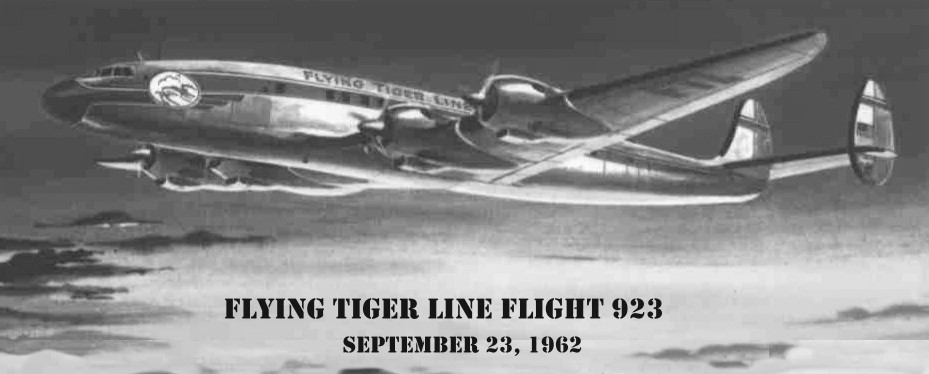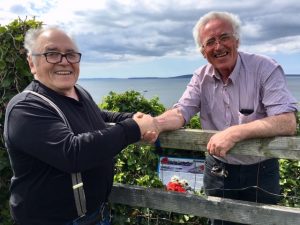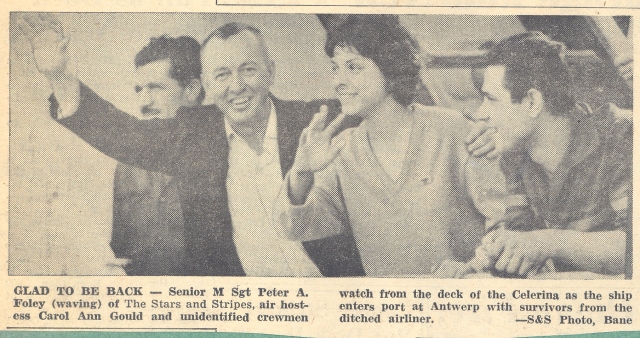Saturday, September 23, 2023 is the 61st Anniversary of the little known tragedy of Flying Tiger Flight 923, ditching some 500 miles off the west coast of Ireland. It was at night in the middle of the frigid, raging North Atlantic Ocean. Seventy six souls were on board, men, women and children. Twenty eight perished while 48 miraculously survived after a six-hour wind and wave-tossed raft ride and joyous connection with the Swiss freighter, the Celerina. The date was September 23, 1962, just as the “cold war” was heating up with the “Cuban Missile Crisis.”
There was very little news of the event. Frankly, there seemed to be a whole lot of silence, considering the vast volumes of publicity given most airplane crashes of the time. Even the families of the combat paratroopers who died that night received little more than a telegram notifying them of the death of their sons. There were no commemorations or memorials.
After living with the quiet tone of the event for nearly 50 years, this web site was created to give some recognition to those who lived and died and those responsible for rescue operations. I was motivated to get involved because I realized what a major factor this Flying Tiger crash played in my life. I not only survived, but circumstances led me to my lifelong career, my marriage to a green-eyed Irish cowgirl, the adoption of Ireland as my second country of residence, and the ownership of a lovely, historic farm house in a very beautiful part of Ireland. This is all true, but yet I knew so little about what had driven me all of those 50 years.
My father gave me a head start by saving anything he could find about the crash, although there was very little to find. Most of it was in the form of small news clips, minus the names of most sources and dates.

I worked with the little I had and, quickly in the process, I discovered there were really hundreds of people involved, including 1,500 crew members on one Canadian aircraft carrier that delivered several recovered bodies to Shannon, Ireland, and four fellows who comprised the first emergency rescue team at the new Cork, Ireland airport.
This web site was started with that small bit of seed information and has expanded to include more than 112 stories and has garnered more than 126,000 public views since its beginning. Word of mouth has led to the discovery of more information and more stories.
By the 50th anniversary, other things were happening to revive the memory of Flying Tiger 923. I had just recently completed my book in 2007, Born Again Irish. The book quickly sold out its first printing of 2,000 copies and as books are traditionally passed around, more people came up with more memories.
Far more people in Ireland were aware of the crash than in the U.S. I made friends with the lighthouse keeper of the Galley Head light house near Clonakilty, which was the rendezvous point for ambulances and helicopters during the evacuation of the first group of injured passengers from the rescue ship to hospitals in Cork City some 30 miles away. I was lucky enough to be a part of that group of 17 although my injuries in my mind were minor. The helicopter flight over Galley Head was the point at which I fell in love with Ireland.
As with most conversations, one thing leads to another and an Irish fisherman said you ought to do your own memorial. And that got the ball rolling. I arranged to have a memorial engraved and organized a public ceremony on the day of the 50th anniversary. With less than two weeks of preparation, we were able to arouse nearly 100 people to attend, including the Swiss Ambassador to Ireland and a representative of the Swiss rescue ship, who had been on the Celerina during the rescue operations.
At the exact same time as our proceedings at Galley Head, Mike Flahive and his family arranged a ceremony on his farm on the Bowmar Cliffs. The farm overlooks the Shannon River estuary near the Shannon Airport. He is keeping his beautiful memorial open to the public.
In Switzerland, two feature reporters from two of the four stations of the Swiss National Public Radio were broadcasting their on-the-scene reports. Both came to Ireland to see first-hand the good work and fondness everyone felt for the Swiss rescue ship, the Celerina, and its crew of more than 30 who participated in the three-day recovery operation.
Above is the first memorial to the Flying Tiger 923 affixed to the entry of Galley Head Light House, which was the flyover point for rescue helicopters and the first land seen by 17 of the more seriously injured of the survivors. Most of these injured were suffering from serious burns caused by the combination of aviation fuel and salt water soaked into wool uniforms and rubbed into the skin over the six hour trip in the life raft. The memorial was placed at Galley Head on September 23, 2012.
During this period of time, a seasoned author by the name of Eric Lindner was beginning his very serious search into the demise of Flying Tiger 923. His wife, Ellen, is the daughter of the pilot, Captain John Murray, who at the time of the crash was a young child. She and the entire Murray familyand always wanted to know more about the crash and wondered why so little was known about it. Lindner made use of the information in this web site in the development of his very comprehensive and interesting book. Anyone with even the slightest interest in this crash should get a copy of Tiger in the Sea. It’s a great book.
Incidentally, since the publication of this book, which is available in hardbound, audio and kindle formats, the number of public views of this web site has been increasing significantly.
And now for a small confession from me to all readers and to those who may not read but know me: for more than 50 years I have lived with the compelling desire to say thank you to the crew of the airplane that changed its direction and got on our tail and followed us to splash down. I will forever remember my six hours confined in that crowded rubber raft, seeing an airplane circling above us and the thrill and wave of renewed hope and confidence every time a marking flare was dropped. I tried in all sincerity to say thank you in my book, only to have a young lawyer from New York City phone me in no uncertain terms that I had not only acknowledged the wrong crew, but had the wrong airline. His father was the crew leader and the plane was a U.S. Air Force transport carrier going in the opposite direction. Embarrassing is an understatement. You can read about that aircraft and crew and that feat of heroism in this website.
And thank you again and again for all of the hundreds of heroes who made it possible for us to celebrate this year and all of those anniversaries in the past. These heartfelt thanks include the lovely nurses at Mercy Hospital in Cork, five of whom came to the party to celebrate the release of my book, Born Again Irish, on anniversary 45. Back in the day, in 1962, they were five of the most beautiful red haired, blue eyed lassies dressed in white nurse’s uniforms treating the survivors. Many years later, they were still beautiful, even dressed in the traditional black robes of catholic nuns.
What different and interesting roads we all take on this journey of life. No two of us can be the same. We all do the best we can at whatever time we are doing it and we keep moving on.
And one more important thank you to our hero, Captain John Murray, for his skill and judgement that dark night in 1962 that saved so many lives.


























 engine on this aircraft blew up during a training mission off Florida on October 3rd 2002. The two crew ejected safely and were recovered. The tail fin must have separated
engine on this aircraft blew up during a training mission off Florida on October 3rd 2002. The two crew ejected safely and were recovered. The tail fin must have separated